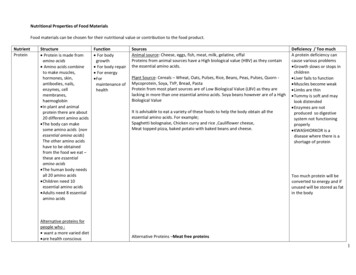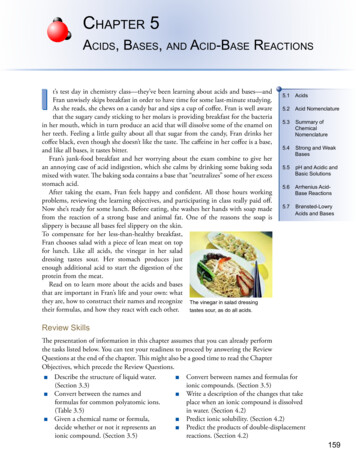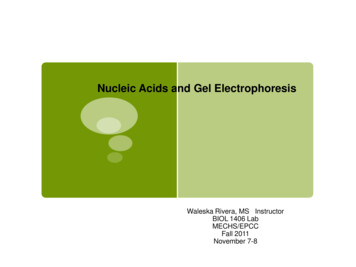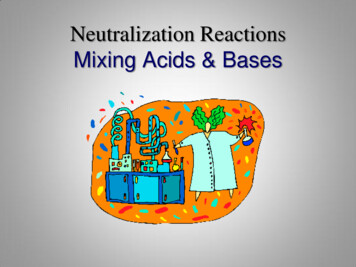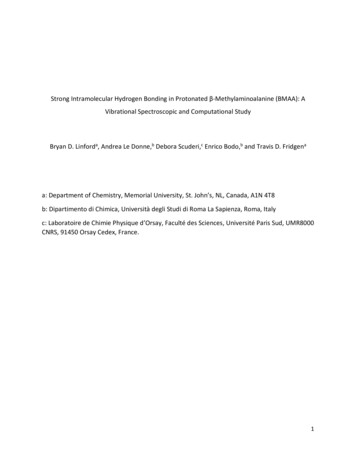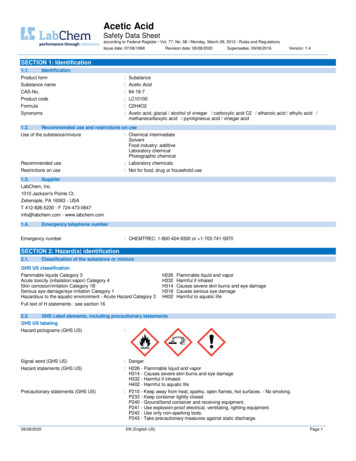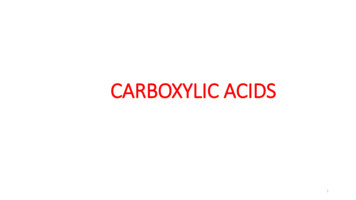
Transcription
CARBOXYLIC ACIDS1
Carboxylic AcidsIntroductionCarboxylic acids are organic compounds containing the carboxylgroup (-COOH), wherein the hydroxyl group (-OH) is directlyattached to the carbonyl (C O) group.Carboxylic acids constitute one of the most frequentlyencountered classes of organic compounds in nature.2
Natural Carboxylic AcidsA great many carboxylic acids are encountered in nature, mostly,in fruits. Indeed carboxylic acids were among the first class oforganic compounds to ever be isolated from nature.Edible carboxylic acids found in citrous fruits and fermentedmilk generally have sharp flavours.3
Nomenclature of Carboxylic AcidsThe common names of some basic carboxylic acids are derivedfrom Latin names that indicate the first original natural source ofthe carboxylic acid.Structure of AcidNatural SourceCommonNameOH C OHCH3CH3CH2CH3CH2CH2Ants (Formica)Formic acidOC OHVinegar (Acetum)Acetic acidOC OHBasic Fat (Propio)Propionic acidRancid butter (Butyrum)Butyric acidPresent in aValerian herbValeric acidGoat (Caper)Caproic acidOC OHCH3CH2CH2CH2CH2OC OH4
Common Names of Carboxylic AcidsThe common name of a carboxylic acid (R-COOH) is derived byadding the suffix –ic acid to a prefix representing the chainlength of the carboxylic acid.# of CarbonsPrefixCommon Name of Acid1Form-Formic acid2Acet-Acetic acid3Propion-Propionic acid4Butyr-Butyric acid5Valer-Valeric acid6Capro-Caproic acidAromatic acidBenzo-Benzoic acid5
IUPAC Nomenclature of Aliphatic CarboxylicAcidsIUPAC names of straight chain aliphatic carboxylic acids arederived by adding the suffix –oic acid to the systematic name ofthe parent hydrocarbon. They are named as alkanoic acids.# of Carbons Structure & IUPACName of Alkane1HH C HHMethane2CH3 CH3Ethane3CH3CH2 CH3Structure & IUPACName of AcidOH C OHMethanoic acidCH3OC OHEthanoic acidCH3CH2OC OH6
Systematic Nomenclature of SubstitutedCarboxylic AcidsThe systematic names of substituted aliphatic carboxylic acidsare derived by:(i) First identifying the parent chain that contains most, if notall, the carboxyl groups.(ii) Number the parent chain from the carbon of the carboxylgroup i.e the carboxyl carbon is C-1.(iii) Identify the substituents and assign each substituent alocator/address number (2,3,4 etc.) consistent with thenumbering in the parent chain.(iv) Arrange the names of the substituents in alphabetical orderin the systematic name of the poly-substituted carboxylicacid.8
Systematic Nomenclature of SubstitutedCarboxylic AcidsExampleAll other substituted aliphatic monocarboxylic acids are namedusing the same sequence.9
Systematic Nomenclature of CyclicCarboxylic AcidsThe systematic name of a carboxylic acid in which the COOHgroup is attached directly to a ring is derived by adding a suffix –carboxylic acid to the name of the attached cycloalkane orcycloalkene or yclohexanecarboxylic acidWhen such carboxylic acids are substituted, the carbon of theCOOH group is itself not numbered, but it is, by convention,taken to be attached to C-1 of the ring.10
Systematic Nomenclature of SubstitutedCyclic Carboxylic AcidsFor substituted carboxylic acids with the carboxyl groupattached directly to a ring, the carbon of the COOH group isitself not numbered, but it is, by convention, taken to be attachedto C-1 of the ring.Under this system of nomenclature, benzoic acid would benamed as benzenecarboxylic acid.11
IUPAC Nomenclature of SubstitutedAromatic Carboxylic AcidsSubstituted aromatic acids with one carboxyl group are named asderivatives of benzoic acid, with the position of substituentsbeing cited using the locators (2,3 etc) according to their positionon the benzene ring relative to the carboxyl group. The carbonon which the carboxyl group is attached is by convention C-1.12
Systematic Nomenclature of DicarboxylicAcidsThe systematic name of an open chain aliphatic dicarboxylicacid is derived by adding a suffix -dioic acid to the name of theparent hydrocarbon i.e. alkanedioic acid.Systematic NameCommon NameStructureEthanedioic acidOxalic acidHO2C-CO2HPropanedioic acidMalonic acidHO2CCH2CO2HButanedioic acidSuccinic acidHO2C(CH2)2CO2HPentanedioic acidGlutaric acidHO2C(CH2)3CO2HHexanedioic acidAdipic acidHO2C(CH2)4CO2HHeptanedioic acidPimelic acidHO2C(CH2)5CO2H13
Systematic Nomenclature of SubstitutedDicarboxylic AcidsThe systematic name of an aliphatic dicarboxylic acid is derivedby:(i) First identifying the parent chain that contains the twocarboxylic acid groups and then adding a suffix -dioic acid tothe name of the parent hydrocarbon.(ii) The parent chain is numbered from the end that gives thesubstituents in the chain the lowest possible address number.(iii) The substituents are arranged in alphabetical order in the fullname of the dicarboxylic acid.14
Systematic Nomenclature of CyclicDicarboxylic AcidsThe systematic name of a cyclic aliphatic or aromaticdicarboxylic acid is derived by adding a suffix -dicarboxylicacid to the name of the parent cycloalkane or arene i.e.cycloalkanedicarboxylic acid or arenedicarboxylic acid.The positions of the two carboxyl groups are cited with thelowest possible address numbers to differentiate betweenisomers.15
Properties of Carboxylic AcidsThe physical properties of carboxylic acids can be explainedfrom the perspective of the bond polarization in the carboxylgroup and its capacity to engage in hydrogen-bonding.Carboxylic acids boil at considerably higher temperatures thanalcohols, ketones, or aldehydes of similar molecular weightThe high boiling point of carboxylic acids is attributed to theircapacity to readily form stable, hydrogen-bonded dimers.16
Acidity of Carboxylic AcidsCarboxylic acids may to dissociate to a carboxylate anion and ahydrogen ion (proton).18
Substituent Effects on the Acidity ofAliphatic Carboxylic AcidsCarboxylic acids dissociate to a carboxylate anion and a proton.Any factors that stabilize the excess charge on the carboxylateanion will enhance the acid dissociation constant and hence theacidity of the carboxylic acid.ALKYL GROUPS: EFFECTS OF ELECTRON-DONATING GROUPSName of AcidStructurepKaEffectMethanoic acid HCO2H3.8Ethanoic acid4.7Weakening acidity4.9Negligible effectCH3CO2HPropanoic acid CH3CH2CO2HHeptanoic acid CH3(CH2)5CO2H4.919
Substituent Effects on the Acidity ofAliphatic Carboxylic AcidsELECTRON WITHDRAWING GROUPSName of AcidEthanoic acidStructureCH3CO2HpKaEffect4.7Methoxyethanoic acid CH3OCH2CO2H3.6 EWG’s increaseCyanoethanoic acidN C-CH2CO2H2.5 acidityNitroethanoic acidO2N-CH2CO2H1.7The electron withdrawing groups disperse the negative charge ofthe carboxylate anion thus stabilizing it and promoting itsformation. Note the enhanced acidity in substrates with electronwithdrawing groups.20
Substituent Effects on the Acidity ofAliphatic Carboxylic Acids -HALOGENS: EFFECT OF ELECTRONEGATIVITY ON ACIDITYName of AcidEthanoic acidStructureCH3CO2HpKaEffect4.7Fluoroethanoic acid FCH2CO2H2.6 -Halogen groups increaseChloroethanoic acid ClCH2CO2H2.9 acidityBromoethanoic acid BrCH2CO2H2.9 electronegativitywithincreasingThe increase in acidity with increasing electronegativity of thehalogen is another manifestation of the effectiveness of chargedispersal in the stabilization of the negative charge of thecarboxylate anion.21
Substituent Effects on the Acidity ofAliphatic Carboxylic AcidsCUMMULATIVE EFFECT OF SUBSTITUENTS ON ACIDITYName of AcidStructurepKaEffectChloroethanic acidClCH2CO2H2.9Substituent effects areDichloroethanoic acid Cl2CHCO2H1.3additiveTrichloroethanoic acid Cl3CCO2H0.9The substient effect is cummulative. The more the electronwithdrawing groups the better the stabilization of the carboxylateanion and the higher their acidities.22
Substituent Effects on the Acidity ofAliphatic Carboxylic AcidsEFFECT OF BOND DISTANCE ON ACIDITYName of AcidChloroethanoic acid3-Chloropropanoic acid4-Chlorobutanoic KaEffect2.9 The stabilizingeffect due to the4.0inductive effect4.5 decreasesrapidlywithdistance.Substituents mainly exert their influence on the acidity ofaliphatic carboxylic acid through the inductive effect. Since theinductive effect operates through sigma bonds, it diminishesrapidly with increasing distance from the carboxyl group(number of -bonds).23
Acidity of Aromatic Carboxylic AcidsBenzoic acid is the simplest of aromatic carboxylic acids.Two factors influence the acidity of substituted aromaticcarboxylic acids: The resonance effect and the inductive effect.Whereas the inductive effect only operates through -bonds, theresonances effect operates by electron or charge delocalizationthrough π–bonds.24
Acidity of Aromatic Carboxylic Acids:Inductive EffectWhen an aromatic carboxylic acid has a substituent that doesnot have lone pairs of electrons or charge that can be delocalizedin the aromatic nucleus, then, only the inductive effect can beinvoked in explaining its degree of acidity.Whereas electron donating groups suppress the acidity ofbenzoic acids, electron-withdrawing groups enhance the acidity.25
Acidity of Aromatic Carboxylic Acids:Inductive EffectHalides (F, Cl, Br and I) are usually considered as weakly ringdeactivating through the inductive effect. The halobenzoateanions are more stabilized than benzoate anions, hence thehigher acidity of all isomeric halobenzoic acids relative tounsubstituted benzoic acid.The 2-halobenzoic acids are more acidic than 3-halobenzoicacid, which are more acidic than the 4-halobenzoic acidderivatives.26
Acidity of Aromatic Carboxylic Acids: theResonance EffectWhen both resonance and inductive effects apply in a specifiedsubstrate, the resonance effect dominates the inductive effect andthus determines the order of acidity among isomeric carboxylicacids.The carboxylate anion obtained in the ionization of aromaticcarboxylic acids is best stabilized when there are electronwithdrawing substituents attached to the aromatic nucleus.It is for this reason that the nitrobenzoic acid derivatives, withthe highly electron-withdrawing nitro group, are stronger acidsthan benzoic acid.27
Resonance Structures of IsomericNitrobenzoatesResonance Structures of carboxylate anions derived from ionization of isomeric nitrobenzoic acidsOCOONOCOOo-Nitrobenzoic acidOCOOCOOONOCOOONOHighly stabilizingONOONCOOONOCOOONOOCON OOm-Nitrobenzoic acidOOCNOOp-Nitrobenzoic acidOOCNOOOOCNOOHighly stabilizing28
Synthesis of Carboxylic AcidsOxidation of Primary Alcohols to Carboxylic AcidsThe synthesis of carboxylic acids requires the generation orincorporation of the carboxyl group in a substrate.R CH2OHOxidizing AgentR CO2HAlthough, primary alcohols can be oxidized to carboxylic acidsusing strong oxidizing agents such as CrO3, Na2Cr2O7 , K2Cr2O7or KMnO4, in practice, however, the oxidation of primaryalcohols with acidic chromic acid solutions usually forms esters(acid-catalysed esterification between the carboxylic acid and theunreacted primary alcohol takes place) making this strategysynthetically inefficient.31
Synthesis of Carboxylic AcidsOxidation of Primary Alcohols to Carboxylic AcidsThe best conditions for the oxidation of primary alcohols tocarboxylic acids is under the basic conditions employingpotassium permanganate.Example32
Synthesis of Carboxylic AcidsOxidation of Aldehydes to Carboxylic AcidsR CHOOxidizing AgentR CO2HAldehydes can be oxidised to carboxylic acids by a variety ofoxidizing agents. Both strong and mild oxidizing agents may beemployed successfully.Note that Ag2O does not oxidize alcohols33
Synthesis of Carboxylic AcidsOxidation of Aldehydes to Carboxylic AcidsOxidations of aldehydes with KMnO4 in basic media yields acarboxylate salt that must be acidified to provide the freecarboxylic acid.Some aldehydes may contain other functional groups that aresensitive to oxidation. The selective oxidation of such aldehydesrequires the use of mild and selective oxidizing agents foraldehydes such as silver(I)oxide.34
Synthesis of Carboxylic AcidsOzonolysis of Alkenes to Carboxylic AcidsOzonolysis of appropriately substituted alkenes under oxidativecleavage (H2O2) conditions provides carboxylic acids.35
Ozonolysis of Alkynes to Carboxylic AcidsOzonolysis of alkynes under hydrolytic conditions lends accessto carboxylic acids.Terminal alkynes are strategic substrates in the synthesis ofcarboxylic acids because the methanoic acid formed can bereadily washed with water leaving the other carboxylic acidrelatively pure.36
Carboxylation of Grignard ReagentsThe reaction of Grignard reagents with carbon dioxide can beused to prepare carboxylic acids containing one more carbonatom than the parent alkyl/aryl halide of the organomagnesiumreagent.The nucleophilic carbon atom of the organometallic reagentattacks the carbon of the carbonyl group, while the magnesiumatom complexes with the oxygen atom.37
Carboxylation of Grignard ReagentsBoth aliphatic and aromatic carboxylic acids can be prepared bycarboxylation of Grignard reagents.Examples38
Hydrolysis of NitrilesAcid-catalysed hydrolysis of nitriles provides carboxylic acids.Most aliphatic nitriles are obtained by a nucleophilic substitutionreaction of cyanide ions with alkyl halides.Example39
Side-Chain Oxidation of Alkylbenzenes to BenzoicAcidsOxidation of alkylbenzenes using strong oxidizing agentsprovides benzoic acids. The entire alkyl chain, regardless of itslength, is oxidised to a carboxyl (-COOH) group.40
Reactions of Carboxylic AcidsThe reactions of carboxylic acids can be directed to various siteson the carboxyl group.Reactions of carboxylic acids can be placed into four categories:(1) Reactions at the acidic hydrogen on the carboxyl group.(2) Reactions at the carbonyl group(3) Reactions at the carboxylate oxygen(4) Reactions that lead to loss of the carboxyl group as CO241
Reaction of Carboxylic Acids with SodiumBicarbonateMost carboxylic acids (pKa 5) are stronger acids than carbonicacid (H2CO3) (pKa 6.4). Consequently they displace carbonicacid from its salts (hydrogen carbonates). The most reliable testfor carboxylic acids employs NaHCO3 leading to evolution ofCO2. This is commonly called the bicarbonate test for carboxylicacids.ExampleOC OHBenzoic acid NaHCO3OC ONaSodium benzoate H2O CO242
Reactions of Carboxylic Acids with Strong BasesOR C O H NaOHOR C ONa H2OBases such as metal hydroxides (NaOH and KOH) and aminesabstract the acidic proton on carboxylic acids to formcarboxylate salts.MechanismOR C O H OHOR C O H O HExampleOC OHBenzoic acid NaOHOC ONaSodium benzoate H2O43
Reaction of Carboxylic Acids with DiazomethaneDiazomethane reacts rapidly with carboxylic acids to providemethyl esters.Diazomethane can be written in two resonance stabilized forms.Example44
Mechanism of Esterification with DiazomethaneStep 1: Deprotonation of the acidic proton on the carboxylicacid by diazomethane provides a carboxylate anion and amethyldiazonium ion.Step 2: Loss of nitrogenAlthough the carboxylate anions are weak nucleophiles theyreact with very reactive electrophilic alkylating agents likemethyldiazonium ion with loss of nitrogen gas (a good leavinggroup).45
Acid-Catalysed Esterification of Carboxylic AcidsThe traditional method for converting carboxylic acids to estersis through an acid-catalyzed esterification in the presence of analcohol: Commonly referred to as the Fischer esterification.OR C OH R'OHH2SO4OR C OR' H2OThe acid-catalyst can be provided by strong mineral acids suchas H2SO4, HCl and H3PO4 or organic acids such asbenzenesulphonic acid or p-toluenesulphonic acid.Example46
Mechanism of the Acid-Catalysed Esterification ofCarboxylic AcidsStep 1: Protonation of the carbonyl oxygen of the carboxylicacid (activation of the carbonyl carbon).OR C OH HAcidCatalystHOR C OHProtonatedcarboxylic acidStep 2: Nucleophilic attack of the alcohol to the activatedcarbonyl and proton tranferStep 3: Loss of water to give the conjugate acid of the ester andregeneration of acid catalyst.47
Reaction of Carboxylic Acids with AminesAmines, being organic bases, react with carboxylic acids to formammonium salts.OR C O H R' N HR'HR' N HR'Ammonium saltOR C OMechanismOR C O H R' N HR'HR' N HR'Ammonium saltOR C OExampleOC OHBenzoic acidEt H NEtOC OEtH N HEt48
Reaction of Carboxylic Acids with Amines inPresence of DCCPrimary and secondary amines react with carboxylic acids in thepresence of DCC to form amides.OR C OH R' NH2 OHR C N R'N C NAmide1,3-Dicyclohexylcarbodiimide(DCC) OHHN C NDicyclohexylurea(DCHU)DCC serves to activate the carboxyl group of the carboxylic acidto aid in coupling to the amino group.OCO2H CH3N HNDCC CH3OHHN C l-m-toluamide (Deet) is a common mosquito & tickrepellent readily made from m-toluic acid using DCC.49
Mechanism of Coupling Carboxylic Acids withAmines Using DCCThe DCC serves to activate the hydroxyl group attached to thecarbonyl of the carboxyl group; thus converting it to a goodleaving group. N C NOR C O ORR'NHH OHN C N OR C OOO C RN CNHHN C NOR C OC NNHR' N H HHN C NOR C O HORNHR'OHN C N HORNHR' OHHN C N50
Reaction of Carboxylic Acids withPhosphorus PentachlorideCarboxylic acids react with phosphorus pentachloride to provideacid chlorides.The success of the reaction depends on the strength of the P Obond that is formed in phosphorus oxytrichloride.Example51
Reduction of Carboxylic Acids to PrimaryAlcoholsCarboxylic acids are reduced to primary alcohols when treatedwith a strong reducing agent such as LiAlH4.(1) LiAlH4R CO2H(2) H2O or Dilute acidR CH2 OHExamplePh CO2H(1) LiAllH4PhOH(2)H2OMedium strength reducing agents such as sodium borohydride(NaBH4) that reduce aldehydes and ketones are not sufficientlystrong to reduce carboxylic acids.53
a Effect Methanoic acid HCO 2 H 3.8 Ethanoic acid CH 3 CO 2 H 4.7 Weakening acidity Propanoic acid CH 3 CH 2 CO 2 H 4.9 Negligible effect Heptanoic acid CH 3 (CH 2) 5 CO 2 H 4.9. Substituent Effects on the Acidity of Aliphatic Carboxylic Acids 20 ELECTRON WITHDRAWING G

